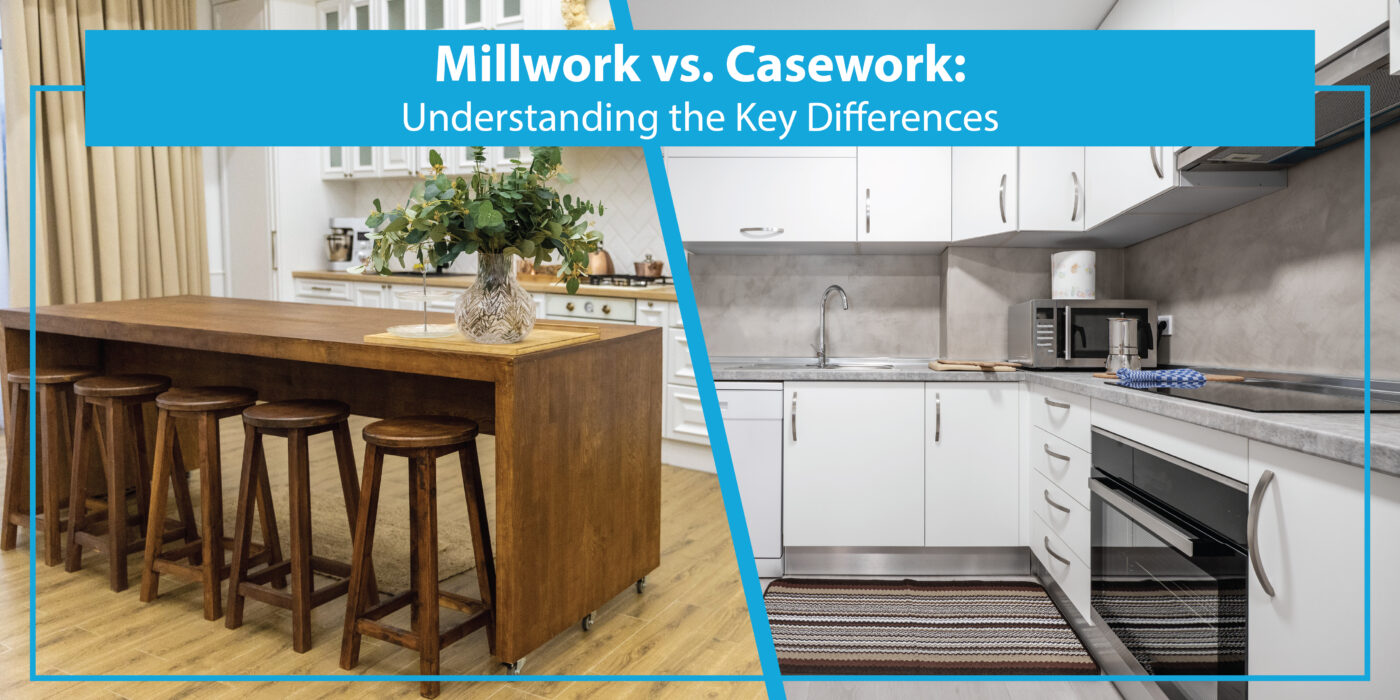When it comes to interior design and construction, two terms that often come up are “millwork” and “casework.” While these terms may sound similar, they refer to distinct elements that play crucial roles in creating functional and aesthetically pleasing spaces. Understanding the key differences between millwork and casework is essential for anyone involved in the design or renovation process. In this blog post, we will delve into the nuances of Millwork construction and casework, exploring their definitions, purposes, and how they contribute to the overall look and feel of a space. Whether you’re a homeowner, architect, or design enthusiast, this guide will help you confidently navigate these concepts.
What is Millwork?
Millwork refers to the customized wooden architectural elements and finished carpentry found in interior spaces. It involves the precise crafting and installation of various woodwork components, such as moldings, trim, doors, cabinetry, and built-in furniture. Millwork is typically created by skilled artisans who use specialized tools and techniques to shape and manipulate wood into intricate designs. These crafted pieces are then installed in residential, commercial, and institutional settings to add both functionality and aesthetic appeal to the space. Millwork or millwork construction plays a significant role in enhancing the overall architectural style, character, and visual impact of a room, creating a sense of craftsmanship and refinement.
What is Casework?
Casework refers to installing pre-built cabinets, shelves, and storage units in interior spaces. Unlike millwork, which involves custom woodworking, casework involves the use of standardized modular components that are manufactured off-site and then assembled on-site. Casework offers versatility and efficiency, allowing for quick installation and customization options. It is commonly used in residential, commercial, and institutional settings to provide functional storage solutions and organization. From kitchen cabinets and bathroom vanities to office storage systems and retail display units, casework construction offers a wide range of design possibilities to optimize space utilization while maintaining a sleek and streamlined aesthetic.
Benefits: Millwork vs Casework
The choice between millwork and casework depends on the specific project requirements, budget, desired aesthetic, and timeline. Both options offer unique benefits that can enhance interior spaces in different ways.
Millwork Benefits:
- Customization: Millwork allows for limitless customization options, as each piece is crafted according to specific millwork design requirements. Architectural millwork ensures a perfect fit and unique aesthetic appeal.
- Architectural Character: Millwork adds architectural character and visual interest to interior spaces, creating a sense of craftsmanship and elegance.
- Quality Craftsmanship: Millwork construction is often created by skilled artisans who pay meticulous attention to detail, resulting in high-quality and durable woodwork.
- Flexibility: Millwork or Architectural millwork can be adapted to suit various architectural styles and several millwork design concepts, offering versatility in creating cohesive and personalized interiors.
Casework Benefits:
- Efficiency: Casework is prefabricated off-site, allowing for faster installation and reduced construction time compared to custom millwork.
- Cost-Effective: Casework is typically less expensive than millwork since it utilizes standardized modular components, making it a budget-friendly option.
- Consistency: Casework ensures consistent quality and dimensions since it is manufactured using precise production methods and machinery.
- Versatility: Casework construction offers a wide range of storage and organizational solutions, making it ideal for both residential and commercial applications where functionality is key.
Application: Millwork v/s Casework
Discover the diverse uses of millwork and casework construction, and how they enhance the functionality and aesthetics of interior spaces in distinct yet complementary ways.
Millwork Applications:
Millwork design is often employed to create intricate moldings, such as crown moldings, baseboards, and chair rails. These elements add a touch of elegance and sophistication to walls and ceilings. Millwork construction is ideal for crafting custom cabinetry and built-in storage solutions. From kitchen cabinets and bathroom vanities to bookshelves and entertainment centers, architectural millwork enhances functionality while providing a seamless and stylish integration with the overall design. Architectural millwork extends to the creation of custom doors and windows. These meticulously crafted elements not only serve their functional purposes but also contribute to the overall aesthetic appeal of a space. Also, these can be utilized to design and construct paneling and wainscoting, adding texture, depth, and visual interest to walls.
Casework Applications:
Casework construction finds widespread use in commercial spaces such as offices, retail stores, and hospitality venues. It involves the installation of modular cabinetry, display cases, and storage units to optimize organization and functionality. Casework is commonly employed in educational institutions to provide storage solutions in classrooms, laboratories, and libraries. It offers durability and flexibility, allowing for easy reconfiguration as per changing needs. Casework is used extensively in healthcare facilities for storage, shelving, and built-in cabinetry solutions in patient rooms, laboratories, and administrative areas. Casework construction also offers practical storage solutions in residential settings, including closets, laundry rooms, and garages. Modular cabinets and shelves provide organization and maximize space utilization.
Costing: Millwork vs. Casework – Comparing Financial Considerations
When it comes to cost, there are significant differences between millwork and casework in interior design projects. Millwork, being custom-made, tends to have a higher price tag due to the craftsmanship and customization involved. The materials, intricate detailing, and skilled labor contribute to Millwork construction’s elevated cost. On the other hand, casework offers a more budget-friendly option as it utilizes standardized modular components, reducing manufacturing and installation expenses. Casework’s cost-effective nature makes it a popular choice for projects with limited budgets or when time constraints are a factor. Ultimately, the decision between millwork and casework relies on the project’s financial resources and the desired level of customization and quality.
Which is preferable? Millwork v/s Casework
The preference between millwork and casework ultimately depends on the specific needs and priorities of a project. Millwork is favored when customization, craftsmanship, and a high-end aesthetic are of utmost importance. It offers limitless design possibilities, architectural character, and an unparalleled level of attention to detail. On the other hand, casework is preferred for its cost-effectiveness, efficiency, and versatility. It provides standardized storage solutions, and quick installation, and is well-suited for projects with limited budgets or tight timelines. Ultimately, the choice between Architectural millwork and casework is subjective and should be based on the project’s requirements, design vision, budget, and desired level of customization.
In conclusion,
Both millwork and casework have their unique advantages in interior design. Millwork offers custom craftsmanship and exquisite detailing, while casework provides cost-effective modular solutions. The decision between the two depends on factors such as budget, timeline, and desired level of customization. Ultimately, it’s about finding the right balance between aesthetic appeal, functionality, and financial considerations to create stunning and functional spaces.
To get professional advice and assistance on your construction projects, contact us at Monarch Innovation for our host of millwork and Casework Architectural, Building Design, and Mechanical Engineering services.





